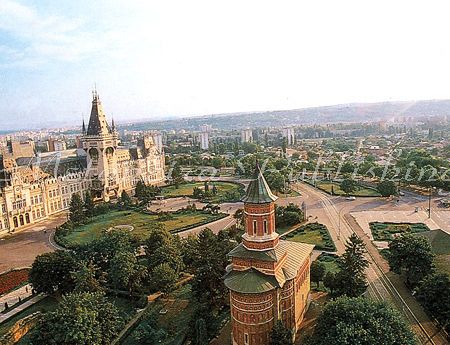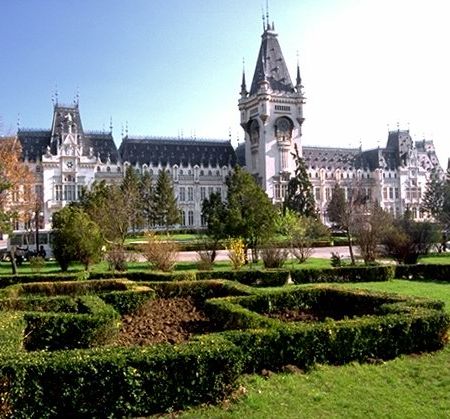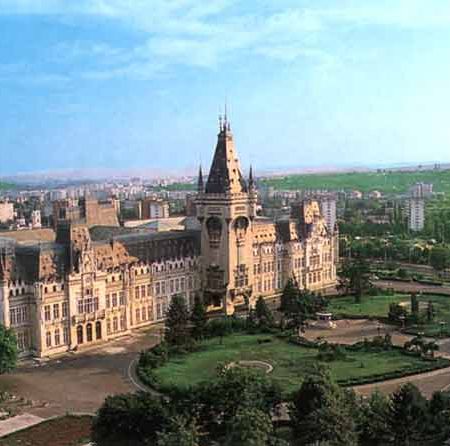One of the oldest and most important city of Romania, Iasi was over it's long history the capital of Moldavia and for a short while of Romania, and nowadays in the fourth largest city of the country, a major cultural and economical centre. It also has the oldest university in Romania and was home to some of it's most famous intelectuals. It's recorded history starts with 1408, when the city is first mentioned in a document, and over the centuries was a place of culture, economical development and power. But also of fierce military and political fighting, the capital of Moldavia and a city which combined the Oriental, European and national influences. By the end of the 19th century it began to develop at a faster rate, in no small part due to the influence of foreign merchants, and the Palace of Culture, the National Theatre of the University were built. It kept on developping during the 20th century, being modernised and extended. It is now a modern and large city.
Sights, museums, places to see
The University : the University Alexandru Ioan Cuza - which bears of name of the ruler who united Moldavia and Valachia in 1859 - is the oldest in Romania and one of the most respected cultural centres of the country. It was actually founded way back in 1860 through a decree given by Cuza himself, and at this time has 15 faculties, with over 40.000 students. It's main building, dating from the last years of the 19th century, is a real work of architectural art, and has a rich and diverse history, an atmosphere that impresses from the start, not to mention it's excelent library, one of the best in the country.
There are also several other universities in the city, such as the Petre Andrei University, the Arts University, the Medical University, but none of these has the importance and "weight" of the Cuza University. Which must be visited, even just to enjoy the beauty of the structure.
Church "Sf. Nicolae Domnesc" : this church bearing the name of St Nicholas was built in 1491 - 1492 by Stephen the Great and at the end of the 19th century was restored, being the oldest place of worship in Iasi still in use. It played a major role in the history of the city, as the place of coronation for most of the rulers, and it is also a splendid architectural achievement. Just as impressive are the interior and outside frescoes, wonderfully preserved

Golia Monastery : it was built by Ioan Golia in the 16th century and later rebuilt, in the 17th century, being at that time one of the largest and most beautiful monasteries in Moldavia, as it mixed Polish, Greek and Russian influences with the original, traditional style. The whole complex was protected from the beginning by a large and strong wall, had a bell-tower 30 meters tall and was a pride for all locals. This tower, the Tower of Golia, is the place to be for those who want to see the whole city from above. After the 120 steps the view is simply amazing.
Mihai Eminescu Central Library : this is the central library of the University in Iasi and surely one of the best in the country. It is hosted in a beautiful and large building, a project signed by Contantin Jotzu and made in the 1930s, in which the library was moved in 1945. Among the collection of special interest is the one of old books, manuscripts and documents, as well as the tens of thousands of books of all kind. For any student or reader, this is the place to be if you like books.
The Vasile Alecsandri National Theatre : the building was finished in just two years, in 1896, and has been one of the greatest achievements at that time and one of the best places in Iasi. Inspired by Vienna architecture, it is a massive and classical structure, large enough in those days for any show or public, and it still keeps the charm of times gone by very much alive. On the ceiling, painted by Al Goltz, you can discover - and surely with awe - a series of beautiful alegories, with nymphs and angels, all in rococo framing, and it is just some of the old decorations, wonderfully preserved. Besides the theatre and special performances, the places also houses the Opera in Iasi. So if you want a good show you must come here

Roznovanu Palace : nowadays is is the mayor's house, but in the past this palace, placed right in the middle of the city, was a place of meeting for the highclass of the ages. The whole place was built in the last decades of the 18th century and fully restaured in the 1830s, under the guidance of Johan Freywald, a famous architect. It is a Neo-Classical project, with rich interior frescoes and statues, decorations and ornaments, and up till 1891 was the property of the Rosetti-Roznovanu family, a highly influential and rich family. Later it was a royal residence, an official building, and was used for various political and artistic events.

Culture Palace in Iasi
Culture Palace : opened officially in 1926 by King Ferdinand himself, this project of I.D. Berindei took almost two decades to be completed, but in the end it proved to have been worth the wait. Built on the site of older structure, it was projected in a Neo-Gothic style, with lots of decorative elements. Today you must vizit the various halls, such as the Rulers Hall, with portraits of Moldavia's rulers and kings of Romania, the Henri Coanda Hall and others. Here you can visit several interesting museums : the Moldavia's History Museum, the Ethnographical Museum, the Art Museum, the Science Museum.
Copou Park : one of the best known parks in the country and one with a beautiful history, closely connected to several famous Romanian poets and writers. This huge public park was organized by Mihalache Sturza at the middle of the 19th century, and has one of the oldest monuments in Romania, the Obelisk or Monument of Constitutional Laws, a tall stone column surrounded by four lions. You will also find here a statue of Eminescu and another one of Ion Creanga. There is also the Junimea Alley, with bronze busts of it's members.
Photo : travelworld.ro ; romanianmonasteries.org ; portal-isj.is.edu.ro
September 2008

































